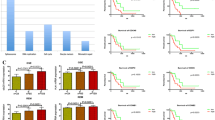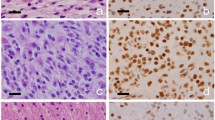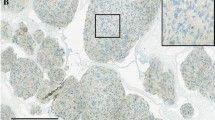Abstract
The CXCR7, a new receptor for CXCL12 with higher affinity than CXCR4 has raised key issues on glioma cell migration. The aim of this study is to investigate the CXCR7 mRNA expression in diffuse astrocytomas tissues and to evaluate its interactions with CXCR4 and HIF1α expression and IDH1 mutation. CXCR7, CXCR4 and HIF1α mRNA expression were evaluated in 129 frozen samples of astrocytomas. IDH1 mutation status was analyzed with gene expressions, matched with clinicopathological parameters and overall survival time. Protein expression was analyzed by immunohistochemistry in different grades of astrocytoma and in glioma cell line (U87MG) by confocal microscopy. There was significant difference in the expression levels of the genes studied between astrocytomas and non-neoplasic (NN) controls (p < 0.001). AGII showed no significant correlation between CXCR7/HIF1α (p = 0.548); there was significant correlation between CXCR7/CXCR4 (p = 0.042) and CXCR7/IDH1 (p = 0.008). GBM showed significant correlations between CXCR7/CXCR4 (p = 0.002), CXCR7/IDH1 (p < 0.001) and CXCR7/HIF1α (p = 0.008). HIF1α overexpression was associated with higher expressions of CXCR7 (p = 0.01) and CXCR4 (p < 0.0001), while IDH1 mutation was associated with lower CXCR7 (p = 0.009) and CXCR4 (p = 0.0005) mRNA expressions. Protein expression increased with malignancy and in U87MG cell line was mainly localized in the cellular membrane. CXCR7 was overexpressed in astrocytoma and correlates with CXCR4 and IDH1 in AGII and CXCR4, IDH1 and HIF1α in GBM. Overexpression HIF1α was related with higher expressions of CXCR7 and CXCR4, otherwise IDH1 mutation related with lower expression of both genes. No association between CXCR7 and CXCR4 expression and survival data was related.









Similar content being viewed by others
References
Dolecek TA, Propp JM, Stroup NE, Kruchko C (2012) CBTRUS statistical report: primary brain and central nervous system tumors diagnosed in the United States in 2005–2009. Neuro Oncol 14(Suppl 5):v1–v49. doi:10.1093/neuonc/nos218
Kleihues P, Louis DN, Scheithauer BW et al (2002) The WHO classification of tumors of the nervous system. J Neuropathol Exp Neurol 61:215–225, discussion 226–229
Janny P, Cure H, Mohr M et al (1994) Low grade supratentorial astrocytomas. Manag Prognostic Factors Cancer 73:1937–1945
Keles GE, Lamborn KR, Berger MS (2001) Low-grade hemispheric gliomas in adults: a critical review of extent of resection as a factor influencing outcome. J Neurosurg 95:735–745. doi:10.3171/jns.2001.95.5.0735
Leighton C, Fisher B, Bauman G et al (1997) Supratentorial low-grade glioma in adults: an analysis of prognostic factors and timing of radiation. J Clin Oncol 15:1294–1301
Schomas DA, Laack NNI, Rao RD et al (2009) Intracranial low-grade gliomas in adults: 30-year experience with long-term follow-up at Mayo clinic. Neuro Oncol 11:437–445. doi:10.1215/15228517-2008-102
Chang EF, Smith JS, Chang SM et al (2008) Preoperative prognostic classification system for hemispheric low-grade gliomas in adults. J Neurosurg 109:817–824. doi:10.3171/JNS/2008/109/11/0817
Van den Bent MJ, Afra D, de Witte O et al (2005) Long-term efficacy of early versus delayed radiotherapy for low-grade astrocytoma and oligodendroglioma in adults: the EORTC 22845 randomised trial. Lancet 366:985–990. doi:10.1016/S0140-6736(05)67070-5
Stupp R, Mason WP, van den Bent MJ et al (2005) Radiotherapy plus concomitant and adjuvant temozolomide for glioblastoma. N Engl J Med 352:987–996. doi:10.1056/NEJMoa043330
Balkwill F (2004) Cancer and the chemokine network. Nat Rev Cancer 4:540–550. doi:10.1038/nrc1388
Gerber PA, Hippe A, Buhren BA et al (2009) Chemokines in tumor-associated angiogenesis. Biol Chem 390:1213–1223. doi:10.1515/BC.2009.144
Kakinuma T, Hwang ST (2006) Chemokines, chemokine receptors, and cancer metastasis. J Leukoc Biol 79:639–651. doi:10.1189/jlb.1105633
Calatozzolo C, Canazza A, Pollo B et al (2011) Expression of the new CXCL12 receptor, CXCR7, in gliomas. Cancer Biol Ther 11:242–253
D’Alterio C, Consales C, Polimeno M et al (2010) Concomitant CXCR4 and CXCR7 expression predicts poor prognosis in renal cancer. Curr Cancer Drug Targets 10:772–781
Gebauer F, Tachezy M, Effenberger K et al (2011) Prognostic impact of CXCR4 and CXCR7 expression in pancreatic adenocarcinoma. J Surg Oncol 104:140–145. doi:10.1002/jso.21957
Hattermann K, Held-Feindt J, Lucius R et al (2010) The chemokine receptor CXCR7 is highly expressed in human glioma cells and mediates antiapoptotic effects. Cancer Res 70:3299–3308. doi:10.1158/0008-5472.CAN-09-3642
Balabanian K, Lagane B, Infantino S et al (2005) The chemokine SDF-1/CXCL12 binds to and signals through the orphan receptor RDC1 in T lymphocytes. J Biol Chem 280:35760–35766. doi:10.1074/jbc.M508234200
Burns JM, Summers BC, Wang Y et al (2006) A novel chemokine receptor for SDF-1 and I-TAC involved in cell survival, cell adhesion, and tumor development. J Exp Med 203:2201–2213. doi:10.1084/jem.20052144
Arvidsson Y, Bergström A, Arvidsson L et al (2010) Hypoxia stimulates CXCR4 signalling in ileal carcinoids. Endocr Relat Cancer 17:303–316. doi:10.1677/ERC-09-0085
Liu H, Xue W, Ge G et al (2010) Hypoxic preconditioning advances CXCR4 and CXCR7 expression by activating HIF-1α in MSCs. Biochem Biophys Res Commun 401:509–515. doi:10.1016/j.bbrc.2010.09.076
Liu Y-L, Yu J-M, Song X-R et al (2006) Regulation of the chemokine receptor CXCR4 and metastasis by hypoxia-inducible factor in non small cell lung cancer cell lines. Cancer Biol Ther 5:1320–1326
Sun X, Wei L, Chen Q, Terek RM (2010) CXCR4/SDF1 mediate hypoxia induced chondrosarcoma cell invasion through ERK signaling and increased MMP1 expression. Mol Cancer 9:17. doi:10.1186/1476-4598-9-17
Schioppa T, Uranchimeg B, Saccani A et al (2003) Regulation of the chemokine receptor CXCR4 by hypoxia. J Exp Med 198:1391–1402. doi:10.1084/jem.20030267
Parsons DW, Jones S, Zhang X et al (2008) An integrated genomic analysis of human glioblastoma multiforme. Science 321:1807–1812. doi:10.1126/science.1164382
Dang L, White DW, Gross S et al (2009) Cancer-associated IDH1 mutations produce 2-hydroxyglutarate. Nature 462:739–744. doi:10.1038/nature08617
Göttle P, Kremer D, Jander S et al (2010) Activation of CXCR7 receptor promotes oligodendroglial cell maturation. Ann Neurol 68:915–924. doi:10.1002/ana.22214
Valente V, Teixeira SA, Neder L et al (2009) Selection of suitable housekeeping genes for expression analysis in glioblastoma using quantitative RT-PCR. BMC Mol Biol 10:17. doi:10.1186/1471-2199-10-17
Livak KJ, Schmittgen TD (2001) Analysis of relative gene expression data using real-time quantitative PCR and the 2(−Delta Delta C(T)) Method. Methods 25:402–408. doi:10.1006/meth.2001.1262
Uno M, Oba-Shinjo SM, da Silva R et al (2011) IDH1 mutations in a Brazilian series of Glioblastoma. Clinics (Sao Paulo) 66:163–165
Hermann PC, Huber SL, Herrler T et al (2007) Distinct populations of cancer stem cells determine tumor growth and metastatic activity in human pancreatic cancer. Cell Stem Cell 1:313–323. doi:10.1016/j.stem.2007.06.002
Ehtesham M, Mapara KY, Stevenson CB, Thompson RC (2009) CXCR4 mediates the proliferation of glioblastoma progenitor cells. Cancer Lett 274:305–312. doi:10.1016/j.canlet.2008.09.034
Salmaggi A, Maderna E, Calatozzolo C et al (2009) CXCL12, CXCR4 and CXCR7 expression in brain metastases. Cancer Biol Ther 8:1608–1614
Hartmann TN, Burger M, Burger JA (2004) The role of adhesion molecules and chemokine receptor CXCR4 (CD184) in small cell lung cancer. J Biol Regul Homeost Agents 18:126–130
Wang J, Shiozawa Y, Wang J et al (2008) The role of CXCR7/RDC1 as a chemokine receptor for CXCL12/SDF-1 in prostate cancer. J Biol Chem 283:4283–4294. doi:10.1074/jbc.M707465200
Miao Z, Luker KE, Summers BC et al (2007) CXCR7 (RDC1) promotes breast and lung tumor growth in vivo and is expressed on tumor-associated vasculature. Proc Natl Acad Sci U S A 104:15735–15740. doi:10.1073/pnas.0610444104
Iwakiri S, Mino N, Takahashi T et al (2009) Higher expression of chemokine receptor CXCR7 is linked to early and metastatic recurrence in pathological stage I nonsmall cell lung cancer. Cancer 115:2580–2593. doi:10.1002/cncr.24281
Zheng K, Li H-Y, Su X-L et al (2010) Chemokine receptor CXCR7 regulates the invasion, angiogenesis and tumor growth of human hepatocellular carcinoma cells. J Exp Clin Cancer Res 29:31. doi:10.1186/1756-9966-29-31
Liang JJ, Zhu S, Bruggeman R et al (2010) High levels of expression of human stromal cell-derived factor-1 are associated with worse prognosis in patients with stage II pancreatic ductal adenocarcinoma. Cancer Epidemiol Biomarkers Prev 19:2598–2604. doi:10.1158/1055-9965.EPI-10-0405
Wang L, Chen W, Gao L et al (2012) High expression of CXCR4, CXCR7 and SDF-1 predicts poor survival in renal cell carcinoma. World J Surg Oncol 10:212. doi:10.1186/1477-7819-10-212
Hao M, Zheng J, Hou K et al (2012) Role of chemokine receptor CXCR7 in bladder cancer progression. Biochem Pharmacol 84:204–214. doi:10.1016/j.bcp.2012.04.007
Maishi N, Ohga N, Hida Y et al (2012) CXCR7: a novel tumor endothelial marker in renal cell carcinoma. Pathol Int 62:309–317. doi:10.1111/j.1440-1827.2012.02792.x
Schrevel M, Karim R, ter Haar NT et al (2012) CXCR7 expression is associated with disease-free and disease-specific survival in cervical cancer patients. Br J Cancer 106:1520–1525. doi:10.1038/bjc.2012.110
Takano S, Yamashita T, Ohneda O (2010) Molecular therapeutic targets for glioma angiogenesis. J Oncol 2010:351908. doi:10.1155/2010/351908
Wang Y-N, Hung M-C (2012) Nuclear functions and subcellular trafficking mechanisms of the epidermal growth factor receptor family. Cell Biosci 2:13. doi:10.1186/2045-3701-2-13
Brand TM, Iida M, Li C, Wheeler DL (2011) The nuclear epidermal growth factor receptor signaling network and its role in cancer. Discov Med 12:419–432
Wang S-C, Hung M-C (2009) Nuclear translocation of the epidermal growth factor receptor family membrane tyrosine kinase receptors. Clin Cancer Res 15:6484–6489. doi:10.1158/1078-0432.CCR-08-2813
Rong Y, Durden DL, Van Meir EG, Brat DJ (2006) “Pseudopalisading” necrosis in glioblastoma: a familiar morphologic feature that links vascular pathology, hypoxia, and angiogenesis. J Neuropathol Exp Neurol 65:529–539
Kioi M, Vogel H, Schultz G et al (2010) Inhibition of vasculogenesis, but not angiogenesis, prevents the recurrence of glioblastoma after irradiation in mice. J Clin Invest 120:694–705. doi:10.1172/JCI40283
Ceradini DJ, Kulkarni AR, Callaghan MJ et al (2004) Progenitor cell trafficking is regulated by hypoxic gradients through HIF-1 induction of SDF-1. Nat Med 10:858–864. doi:10.1038/nm1075
Pugh CW, Ratcliffe PJ (2003) Regulation of angiogenesis by hypoxia: role of the HIF system. Nat Med 9:677–684. doi:10.1038/nm0603-677
Zagzag D, Lukyanov Y, Lan L et al (2006) Hypoxia-inducible factor 1 and VEGF upregulate CXCR4 in glioblastoma: implications for angiogenesis and glioma cell invasion. Lab Invest 86:1221–1232. doi:10.1038/labinvest.3700482
Schutyser E, Su Y, Yu Y et al (2007) Hypoxia enhances CXCR4 expression in human microvascular endothelial cells and human melanoma cells. Eur Cytokine Netw 18:59–70. doi:10.1684/ecn.2007.0087
Mendez O, Zavadil J, Esencay M et al (2010) Knock down of HIF-1? in glioma cells reduces migration in vitro and invasion in vivo and impairs their ability to form tumor spheres. Mol Cancer 9:133. doi:10.1186/1476-4598-9-133
Metellus P, Colin C, Taieb D et al (2011) IDH mutation status impact on in vivo hypoxia biomarkers expression: new insights from a clinical, nuclear imaging and immunohistochemical study in 33 glioma patients. J Neurooncol 105:591–600. doi:10.1007/s11060-011-0625-2
Williams SC, Karajannis MA, Chiriboga L et al (2011) R132H-mutation of isocitrate dehydrogenase-1 is not sufficient for HIF-1α upregulation in adult glioma. Acta Neuropathol 121:279–281. doi:10.1007/s00401-010-0790-y
Noushmehr H, Weisenberger DJ, Diefes K et al (2010) Identification of a CpG island methylator phenotype that defines a distinct subgroup of glioma. Cancer Cell 17:510–522. doi:10.1016/j.ccr.2010.03.017
Turcan S, Rohle D, Goenka A et al (2012) IDH1 mutation is sufficient to establish the glioma hypermethylator phenotype. Nature 483:479–483. doi:10.1038/nature10866
Hegi ME, Diserens A-C, Gorlia T et al (2005) MGMT gene silencing and benefit from temozolomide in glioblastoma. N Engl J Med 352:997–1003. doi:10.1056/NEJMoa043331
Leu S, von Felten S, Frank S et al (2013) IDH/MGMT-driven molecular classification of low-grade glioma is a strong predictor for long-term survival. Neuro Oncol 15:469–479. doi:10.1093/neuonc/nos317
Acknowledgments
The authors state that neither the submitted paper nor any similar paper, in whole or in part, other than an abstract or preliminary communication, has been or will be submitted to or published in any other source.
Conflict of Interest
There is no conflict of interest to declare.
Funding
This work was supported by FAPESP projets: # 01/12898-4 and 04/12133-6.
Author information
Authors and Affiliations
Corresponding author
Rights and permissions
About this article
Cite this article
Bianco, A.M., Uno, M., Oba-Shinjo, S.M. et al. CXCR7 and CXCR4 Expressions in Infiltrative Astrocytomas and Their Interactions with HIF1α Expression and IDH1 Mutation. Pathol. Oncol. Res. 21, 229–240 (2015). https://doi.org/10.1007/s12253-014-9813-7
Received:
Accepted:
Published:
Issue Date:
DOI: https://doi.org/10.1007/s12253-014-9813-7




